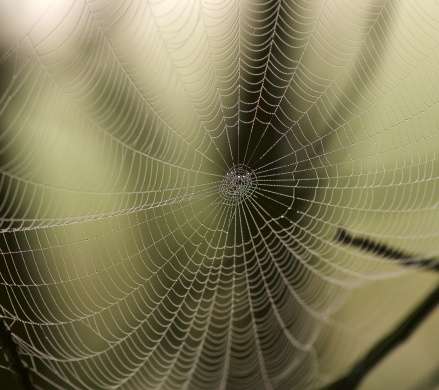The secrets of spider silk

Each time a spider draws silk from its spinneret to create a new web, it also draws on more than 400 million years of evolution. Spiders have evolved to produce a library of silks, each using a different combination of amino acids to address a particular functional need. Some silks are sticky, making them perfect for catching prey. Others are soft and ductile, good for mothers to use in creating nests for their offspring. Most are proportionally stronger than steel and even tougher than Kevlar.
"There has to be something about the material composition of silk that ideally suits it to make web-like structures," said Steve Cranford, a newly appointed assistant professor of civil and environmental engineering.
As a graduate student at MIT, Cranford studied spider silks and other biomaterials under the tutelage of Markus Buehler. "We didn't want to just figure out how spider silk works, what we wanted to do was learn from spider silk and apply it elsewhere," said Cranford.
By better understanding the way nature uses materials to build robust structures, Cranford and his colleagues hope to create their own stronger synthetic materials and structures. Cranford, who has a background in structural engineering, noted that this is a completely different approach from traditional structural engineering, in which materials such as concrete and steel are chosen based on our experience with them, not their suitability for the system.
The fruits of their labor have culminated in the establishment of an entirely new field of research, which Cranford, Buehler, and colleagues from the University of Twente in the Netherlands have dubbed "materiomics." Just as genomics refers to the entire genome as a collective whole greater than the sum of its parts, materiomics considers all the parts in a structure as a single entity with emergent properties.
For instance, bone is typically considered a composite material, a combination of both mineral and protein, but if you separate the two, it's no longer bone, Cranford explained. Steel, concrete, and a reinforced beam are all examples of other composite materials, each contributing to a greater structural whole. "So couldn't you just consider an entire building as a material?" Cranford asked. "What do you consider the material and what do you consider the structure? You can't separate the two."
Earlier in his career Cranford studied seismic design and building failure. But seeking to make an impact in the biological sciences, he ultimately came to view molecules as tiny structures, susceptible to the same forces that impact buildings and bridges. "At a small enough scale, atoms and bonds are just little structures," he said, "From the right perspective, everything starts to look like a beam."
Proteins like spider silk have inspired biomimetic research programs seeking to develop everything from a better heart stent to a lighter bulletproof vest. But the difference between natural molecules and synthetic structures is that the former are the result of eons of evolutionary fine-tuning. Billions of trial and error experiments ensure that the specific sequence of amino acids in structural web silk is ideally suited for its purpose. The key for engineers lies in understanding how the material can contribute and enhance performance, rather than in choosing materials that meet arbitrary structural requirements.
When designing synthetic materials for use in biological settings, say Cranford and his colleagues, researchers should consider structure and function as two sides of the same coin. Steve Cranford, an assistant professor of civil and environmental engineering, studies spider silk and other natural materials for insight into designing more robust synthetic structures.
Provided by Northeastern University




















